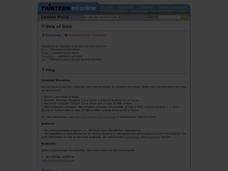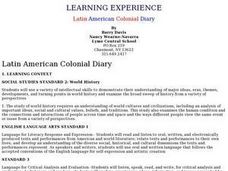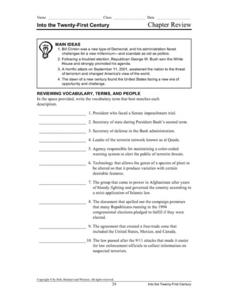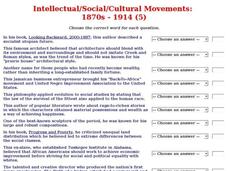Syracuse University
American Industrial Revolution
While the Industrial Revolution may have fueled America's rise to the top of world markets, the child laborers often faced dangerous conditions. Using primary source images and other information, scholars consider what these children...
Northeast Georgia Regional Educational Service Agency
The American Revolution
An empowering lesson explores the causes and complaints that led to the American Revolution. Young scholars, starting in fourth grade, complete hands-on activities, role play, and create cartoons to understand the American Revolution and...
Stanford University
Prohibition
Prohibition banned the selling of alcohol in America—but why? Designed for high school pupils, the lesson explores the causes of Prohibition including the Temperance Movement. The lesson pairs a PowerPoint presentation with worksheets...
Curated OER
Latin American Relief Map
Students, in groups, research, design and construct a relief map of a section of Latin America using papier-mache. They show major landforms, elevations and notable bodies of water. They present their maps to the class.
Curated OER
Trade Missions
Students research the products of countries in Central and South America. t research which products from the countries they represent are imported to the United States. They create tables and/or graphs to indicate annual totals.
Curated OER
Ship of Gold
Students explore American values. In this American history lesson plan, students read passages from Ship of Gold in the Deep Blue Sea. Students collaborate to conduct research in order to build a timeline of the events surrounding the...
Curated OER
Live from Channel 22
Students explore 1920s America. In this American history instructional activity, students research primary and secondary sources in order to examine the events and noteworthy people of the time period. Students use their...
Curated OER
Taking a Stand with Rosa Parks
Students discuss African-American history from slavery to the civil rights movement. They discuss individual people who shpaed history by reading their biographies and researching the age in which they lived. Studnets comprehend the...
Curated OER
5th Grade Social Studies Civics
In this social studies worksheet, 5th graders answer multiple choice questions about America, citizenship, Congress, and more. Students complete 25 multiple choice questions.
Curated OER
The Automobile’s Influence on Post-WWII Suburbia
Eighth graders explore post World War II America. In this American History activity, 8th graders analyze primary and secondary sources to research how the automobile influenced the growth of suburbs, and how the growth of suburbs...
Curated OER
Chapter 10: Racial and Ethnic Relations
In this racial and ethnic relations in America worksheet, learners answer 15 matching questions and respond to 7 short answer questions regarding various racial and ethnic groups terms and issues in U.S. society.
Curated OER
Slavery by the Numbers
Students examine the role of slavery in the United States. In this American history instructional activity, students watch segments of the video "Slavery and the Making of America." Students conduct further research pertaining to Thomas...
Curated OER
The Dust Bowl
Eleventh graders develop an understanding of the Dust Bowl. In this 1930's America lesson, 11th graders respond to questions regarding the songs and literature about the era. The primary sources should be gathered by the instructor.
Curated OER
Chapter 26 – The 1960s & 1970s Counterculture
In this 1960's and 1970's America instructional activity, students read assigned textbook pages regarding the counterculture and respond to 41 short answer questions.
Curated OER
Latin American Colonial Diary
Students examine the class systems of New Spain. In small groups, they create a five-day diary about the family life, food, occupation, and government involvement of an assigned personality from the time of Colonial Latin America.
Curated OER
Worksheet for Analysis of a Political Cartoon
In this primary source analysis worksheet, students respond to 25 short answer questions that require them to analyze the political cartoon titled "America When Feminized."
Curated OER
Three Branches of Government+++A Visual Representation
Third graders identify the three branches of government, describing their functions, and the important people in each branch. They construct models of the buildings and people to visually represent the Legislative, Executive, and...
Curated OER
Into the Twenty-First Century Chapter Review
In this United States into the 21st century worksheet, students review a chapter as they write 10 vocabulary words that match 10 descriptions, correct 1 false statement, and identify 2 themes from the new era of opportunity and challenge...
Curated OER
A Time of Social Change Chapter Review
For this 1960s and 1970s America worksheet, students review a chapter as they define 7 vocabulary terms, eliminate 5 false statements, and identify 3 historical themes pertaining to American society during the 2 decades.
Curated OER
Intellectual/Social/Cultural Movements: 1870s - 1914 (5)
In this online interactive American history worksheet, students answer 12 matching questions regarding late 1870's-1914 America. Students may submit their answers to be scored.
Curated OER
Emu Farm
In this Emu Farm worksheet, students watch the America's Heartland video Emu Farm and fill in the blanks to sentences about it. Students complete 5 sentences.
Curated OER
Southern Strawberries
In this Southern Strawberries worksheet, students watch the America's Heartland video Southern Strawberries and fill in the blanks to sentences about it. Students complete 7 sentences.
Curated OER
Kiwifruit
In this Kiwi worksheet, students watch the America's Heartland video Kiwifruit and fill in the blanks to sentences about it. Students complete 7 sentences.
Curated OER
The Legend of Lady Slipper
In this Native Americans worksheet, students click on the links in the questions about the Ojibwe people to find the answers to the questions and then come back and answer the questions. Students answer 9 questions total.

























